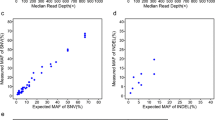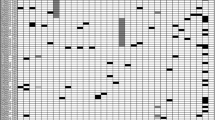Abstract
Background
Mutation testing in the context of neoadjuvant therapy must be performed on biopsy samples. Given the issue of tumour heterogeneity, this raises the question of whether the biopsies are representative of the whole tumour. Here we have compared the mutation profiles of colorectal biopsies with their matched resection specimens.
Methods
We performed next-generation sequencing (NGS) analysis on 25 paired formalin-fixed, paraffin-embedded colorectal cancer biopsy and primary resection samples. DNA was extracted and analysed using the TruSight tumour kit, allowing the interrogation of 26 cancer driver genes. Samples were run on an Illumina MiSeq. Mutations were validated using quick-multiplex-consensus (QMC)-polymerase chain reaction (PCR) in conjunction with high resolution melting (HRM). The paired biopsy and resection tumour samples were assessed for presence or absence of mutations, mutant allele frequency ratios, and allelic imbalance status.
Results
A total of 81 mutations were detected, in ten of the 26 genes in the TruSight kit. Two of the 25 paired cases were wild-type across all genes. The mutational profiles, allelic imbalance status, and mutant allele frequency ratios of the paired biopsy and resection samples were highly concordant (88.75–98.85%), with all but three (3.7%) of the mutations identified in the resection specimens also being present in the biopsy specimens. All 81 mutations were confirmed by QMC-PCR and HRM analysis, although four low-level mutations required a co-amplification at lower denaturation temperature (COLD)-PCR protocol to enrich for the mutant alleles.
Conclusions
Diagnostic biopsies are adequate and reliable materials for molecular testing by NGS. The use of biopsies for molecular screening will enhance targeted neoadjuvant therapy.

Similar content being viewed by others
References
Ferlay J, Soerjomataram I, Dikshit R, Eser S, Mathers C, Rebelo M, et al. Cancer incidence and mortality worldwide: sources, methods and major patterns in GLOBOCAN 2012. Int J Cancer. 2015;136:E359–86. https://doi.org/10.1002/ijc.29210.
Cancer Research UK. http://www.cancerresearchuk.org/health-professional/cancer-statistics/statistics-by-cancer-type/bowel-cancer/. Accessed 20 June 2018.
LeBlanc VG, Marra MA. Next-generation sequencing approaches in cancer: where have they brought us and where will they take us? Farah CS, Cho WC, eds. Cancers. 2015;7(3):1925–58. https://doi.org/10.3390/cancers7030869.
Li J, Wang T, Zhang X, Yang X. The contribution of next generation sequencing technologies to epigenome research of stem cell and tumorigenesis. Hum Genet Embryol. 2011;S2:001. https://doi.org/10.4172/2161-0436.S2-001.
Schmiegel W, Scott RJ, Dooley S, Lewis W, Meldrum CJ, Pockney P, et al. Blood-based detection of RAS mutations to guide anti-EGFR therapy in colorectal cancer patients: concordance of results from circulating tumor DNA and tissue-based RAS testing. Mol Oncol. 2017;11(2):208–19.
Sepulveda AR, Hamilton SR, Allegra CJ, Grody W, Cushman-Vokoun AM, Funkhouser WK, et al. Molecular biomarkers for the evaluation of colorectal cancer: guideline from the American Society for Clinical Pathology, College of American Pathologists, Association for Molecular Pathology, and American Society of Clinical Oncology. J Mol Diagn. 2017;19(2):187–225.
Santos MD, Silva C, Rocha A, Nogueira C, Castro-Poças F, Araujo A, et al. Predictive clinical model of tumor response after chemoradiation in rectal cancer. Oncotarget. 2017;8(35):58133–51.
Lim SH, Chua W, Henderson C, Ng W, Shin JS, Chantrill L, et al. Predictive and prognostic biomarkers for neoadjuvant chemoradiotherapy in locally advanced rectal cancer. Crit Rev Oncol Hematol. 2015;96(1):67–80.
FoxTROT Collaboration Group. Feasibility of preoperative chemotherapy for locally advanced, operable colon cancer: the pilot phase of a randomised controlled trial. Lancet Oncol. 2012;13(11):1152–60.
Jakobsen A, Andersen F, Fischer A, Jensen LH, Jørgensen JCR, Larsen O, et al. Neoadjuvant chemotherapy in locally advanced colon cancer. A phase II trial. Acta Oncol. 2015;54(10):1747–53.
Fadhil W, Ibrahem S, Seth R, AbuAli G, Ragunath K, Kaye P, et al. The utility of diagnostic biopsy specimens for predictive molecular testing in colorectal cancer. Histopathology. 2012;61(6):1117–24.
Greaves M, Maley CC. Clonal evolution in cancer. Nature. 2012;481(7381):306–13.
Fadhil W, Ibrahem S, Seth R, Ilyas M. Quick-multiplex-consensus (QMC)-PCR followed by high-resolution melting: a simple and robust method for mutation detection in formalin-fixed paraffin-embedded tissue. J Clin Pathol. 2010;63(2):134–40.
Seth R, Crook S, Ibrahem S, Fadhil W, Jackson D, Ilyas M. Concomitant mutations and splice variants in KRAS and BRAF demonstrate complex perturbation of the Ras/Raf signalling pathway in advanced colorectal cancer. Gut. 2009;58(9):1234–41.
GraphPad QuickCalcs. http://www.graphpad.com/quickcalcs/kappa2/. Accessed 20 June 2018.
Lowry R. VassarStats: website for statistical computation. http://vassarstats.net/Kappa. Accessed 20 June 2018.
Viera AJ, Garrett JM. Understanding inter-observer agreement: the kappa statistic. Fam Med. 2005;37(5):360–3.
Gajria D, Chandarlapaty S. HER2-amplified breast cancer: mechanisms of trastuzumab resistance and novel targeted therapies. Expert Rev Anticancer Ther. 2011;11(2):263–75.
Abrahao-Machado LF, Scapulatempo-Neto C. HER2 testing in gastric cancer: an update. World J Gastroenterol. 2016;22(19):4619–25.
Bokemeyer C, Cutsem EV, Rougier P, Ciardiello F, Heeger S, Schlichting M, et al. Addition of cetuximab to chemotherapy as first-line treatment for KRAS wild-type metastatic colorectal cancer: pooled analysis of the CRYSTAL and OPUS randomised clinical trials. Eur J Cancer. 2012;48(10):1466–75.
Krol LC, ’t Hart NA, Methorst N, Knol AJ, Prinsen C, Boers JE. Concordance in KRAS and BRAF mutations in endoscopic biopsy samples and resection specimens of colorectal adenocarcinoma. Eur J Cancer. 2012;48(7):1108–15.
Ku BM, Heo MH, Kim J-H, Cho BC, Cho EK, Min YJ, et al. Molecular screening of small biopsy samples using next-generation sequencing in Korean patients with advanced non-small cell lung cancer: Korean Lung Cancer Consortium (KLCC-13-01). J Pathol Transl Med. 2018;52(3):148–56.
Zheng G, Tsai H, Tseng L-H, Gocke CD, Eshleman JR, Netto G, Lin M-T. Test feasibility of next-generation sequencing assays in clinical mutation detection of small biopsy and fine needle aspiration specimens. Am J Clin Pathol. 2016;145:696–702.
Illei PB, Belchis D, Tseng L-H, Nguyen D, De Marchi F, Haley L, et al. Clinical mutational profiling of 1006 lung cancers by next generation sequencing. Oncotarget. 2017;8(57):96684–96.
DiBardino D, Rawson D, Saqi A, Heymann J, Pagan C, Bulman W. Next-generation sequencing of non-small cell lung cancer using a customized, targeted sequencing panel: emphasis on small biopsy and cytology. CytoJournal 2017;14(1):7. http://www.cytojournal.com/text.asp?2017/14/1/7/202602. Accessed 20 June 2018.
Catalogue of somatic mutation in cancer at https://cancer.sanger.ac.uk/. Accessed 20 June 2018.
The Cancer Genome Atlas at https://cancergenome.nih.gov/. Accessed 20 June 2018.
Nurwidya F, Takahashi F, Takahashi K. Gefitinib in the treatment of non-small cell lung cancer with activating epidermal growth factor receptor mutation. J Nat Sci Biol Med. 2016;7(2):119–23. https://doi.org/10.4103/0976-9668.184695.
Tejpar S, Bertagnolli M, Bosman F, Lenz H-J, Garraway L, Waldman F, Warren R, et al. Prognostic and predictive biomarkers in resected colon cancer: current status and future perspectives for integrating genomics into biomarker discovery. Oncologist. 2010;15(4):390–404.
Dienstmann R, Elez E, Argiles G, et al. Analysis of mutant allele fractions in driver genes in colorectal cancer—biological and clinical insights. Mol Oncol. 2017;11(9):1263–72. https://doi.org/10.1002/1878-0261.12099.
Shen S, Wei Y, Zhang R, et al. Mutant-allele fraction heterogeneity is associated with non-small cell lung cancer patient survival. Oncol Lett. 2018;15(1):795–802. https://doi.org/10.3892/ol.2017.7428.
Ono A, Kenmotsu H, Watanabe M, Serizawa M, Mori K, Imai H, et al. Mutant allele frequency predicts the efficacy of EGFR-TKIs in lung adenocarcinoma harboring the L858R mutation. Ann Oncol. 2014;25(10):1948–53. https://doi.org/10.1093/annonc/mdu251.
Doma V, Papp O, Rásó E, Barbai T, Reiniger L, Vízkeleti L, Timar J. Alteration of mutant allele frequency in visceral metastases of melanoma. J Clin Oncol. 2018;36(15_suppl):e21528.
Baldus SE, Schaefer K-L, Engers R, Hartleb D, Stoecklein NH, Gabbert HE. Prevalence and heterogeneity of KRAS, BRAF, and PIK3CA mutations in primary colorectal adenocarcinomas and their corresponding metastases. Clin Cancer Res. 2010;16(3):790–9.
Yun J, Rago C, Cheong I, Pagliarini R, Angenendt P, Rajagopalan H, et al. Glucose deprivation contributes to the development of kras pathway mutations in tumor cells. Science. 2009;325(5947):1555–9.
Acknowledgements
The authors would like to thank Gareth Cross for enabling the process of NGS data generation and analyses.
Author information
Authors and Affiliations
Corresponding author
Ethics declarations
Funding
This work was funded by Universities of Nottingham (for MI) and Leeds (for SDR).
Conflict of interest
All the authors (HH-K, HOE, KM, WF, NSA, SDR and MI) declare that they have no conflicts of interest in publishing this manuscript.
Ethical approval and informed consent
Access to tissues and ethics approval were granted by Nottingham Health Sciences Biobank, which has approval as an IRB from North West–Greater Manchester Central Research Ethics Committee (REC reference: 15/NW/0685).
Electronic supplementary material
Below is the link to the electronic supplementary material.
40291_2019_388_MOESM1_ESM.tif
Supplementary material 1 (TIFF 6040 kb) Online Resource Figure 1: Validation of NGS-detected mutations by HRM analysis. Difference plots obtained for (A) TP53 and (B) KRAS, by HRM analysis. The samples shown were identified by NGS as harbouring mutations and were confirmed by HRM analysis
40291_2019_388_MOESM2_ESM.tif
Supplementary material 2 (TIFF 3908 kb) Online Resource Figure 2: HRM Analysis Difference plots showing enrichment of mutant allele by COLD-PCR. (A) A PIK3CA (c.331_333delAAG) mutation was detected by NGS in this sample. Plot 1 represents PCR products obtained by QMC-PCR, whilst plot 2 denotes PCR products obtained by COLD-PCR. (B) A SMAD4 (c.1082G>A) mutation detected by NGS. Plot 1 is PCR products obtained by QMC-PCR, whereas plot 2 is PCR products obtained by COLD-PCR. * denotes baseline normal DNA
40291_2019_388_MOESM3_ESM.tif
Supplementary material 3 (TIFF 885 kb) Online Resource Figure 3: A grid chart showing the agreement status between Bx and Rx using the ‘mutation-present-or-absent’ test. The coloured boxes denote presence of mutations, whilst the white boxes denote absence of mutations. The coloured boxes without numbers denote that there is only one mutation type between Rx/Bx pair; the numbers in some of the boxes denote the number of mutations for each gene found in the sample pair, whilst the * denotes that the matched Bx lacked the mutation that was found in the Rx. C = concordance, D = discordance
Rights and permissions
About this article
Cite this article
Ham-Karim, H.A., Ebili, H.O., Manger, K. et al. Targeted Next-Generation Sequencing Validates the Use of Diagnostic Biopsies as a Suitable Alternative to Resection Material for Mutation Screening in Colorectal Cancer. Mol Diagn Ther 23, 383–393 (2019). https://doi.org/10.1007/s40291-019-00388-z
Published:
Issue Date:
DOI: https://doi.org/10.1007/s40291-019-00388-z




